Pratap Tokekar
University of Maryland, College Park
Learning Multi-Robot Coordination through Locality-Based Factorized Multi-Agent Actor-Critic Algorithm
Mar 24, 2025Abstract:In this work, we present a novel cooperative multi-agent reinforcement learning method called \textbf{Loc}ality based \textbf{Fac}torized \textbf{M}ulti-Agent \textbf{A}ctor-\textbf{C}ritic (Loc-FACMAC). Existing state-of-the-art algorithms, such as FACMAC, rely on global reward information, which may not accurately reflect the quality of individual robots' actions in decentralized systems. We integrate the concept of locality into critic learning, where strongly related robots form partitions during training. Robots within the same partition have a greater impact on each other, leading to more precise policy evaluation. Additionally, we construct a dependency graph to capture the relationships between robots, facilitating the partitioning process. This approach mitigates the curse of dimensionality and prevents robots from using irrelevant information. Our method improves existing algorithms by focusing on local rewards and leveraging partition-based learning to enhance training efficiency and performance. We evaluate the performance of Loc-FACMAC in three environments: Hallway, Multi-cartpole, and Bounded-Cooperative-Navigation. We explore the impact of partition sizes on the performance and compare the result with baseline MARL algorithms such as LOMAQ, FACMAC, and QMIX. The experiments reveal that, if the locality structure is defined properly, Loc-FACMAC outperforms these baseline algorithms up to 108\%, indicating that exploiting the locality structure in the actor-critic framework improves the MARL performance.
Option Discovery Using LLM-guided Semantic Hierarchical Reinforcement Learning
Mar 24, 2025Abstract:Large Language Models (LLMs) have shown remarkable promise in reasoning and decision-making, yet their integration with Reinforcement Learning (RL) for complex robotic tasks remains underexplored. In this paper, we propose an LLM-guided hierarchical RL framework, termed LDSC, that leverages LLM-driven subgoal selection and option reuse to enhance sample efficiency, generalization, and multi-task adaptability. Traditional RL methods often suffer from inefficient exploration and high computational cost. Hierarchical RL helps with these challenges, but existing methods often fail to reuse options effectively when faced with new tasks. To address these limitations, we introduce a three-stage framework that uses LLMs for subgoal generation given natural language description of the task, a reusable option learning and selection method, and an action-level policy, enabling more effective decision-making across diverse tasks. By incorporating LLMs for subgoal prediction and policy guidance, our approach improves exploration efficiency and enhances learning performance. On average, LDSC outperforms the baseline by 55.9\% in average reward, demonstrating its effectiveness in complex RL settings. More details and experiment videos could be found in \href{https://raaslab.org/projects/LDSC/}{this link\footnote{https://raaslab.org/projects/LDSC}}.
PEnGUiN: Partially Equivariant Graph NeUral Networks for Sample Efficient MARL
Mar 19, 2025Abstract:Equivariant Graph Neural Networks (EGNNs) have emerged as a promising approach in Multi-Agent Reinforcement Learning (MARL), leveraging symmetry guarantees to greatly improve sample efficiency and generalization. However, real-world environments often exhibit inherent asymmetries arising from factors such as external forces, measurement inaccuracies, or intrinsic system biases. This paper introduces \textit{Partially Equivariant Graph NeUral Networks (PEnGUiN)}, a novel architecture specifically designed to address these challenges. We formally identify and categorize various types of partial equivariance relevant to MARL, including subgroup equivariance, feature-wise equivariance, regional equivariance, and approximate equivariance. We theoretically demonstrate that PEnGUiN is capable of learning both fully equivariant (EGNN) and non-equivariant (GNN) representations within a unified framework. Through extensive experiments on a range of MARL problems incorporating various asymmetries, we empirically validate the efficacy of PEnGUiN. Our results consistently demonstrate that PEnGUiN outperforms both EGNNs and standard GNNs in asymmetric environments, highlighting their potential to improve the robustness and applicability of graph-based MARL algorithms in real-world scenarios.
VARP: Reinforcement Learning from Vision-Language Model Feedback with Agent Regularized Preferences
Mar 18, 2025Abstract:Designing reward functions for continuous-control robotics often leads to subtle misalignments or reward hacking, especially in complex tasks. Preference-based RL mitigates some of these pitfalls by learning rewards from comparative feedback rather than hand-crafted signals, yet scaling human annotations remains challenging. Recent work uses Vision-Language Models (VLMs) to automate preference labeling, but a single final-state image generally fails to capture the agent's full motion. In this paper, we present a two-part solution that both improves feedback accuracy and better aligns reward learning with the agent's policy. First, we overlay trajectory sketches on final observations to reveal the path taken, allowing VLMs to provide more reliable preferences-improving preference accuracy by approximately 15-20% in metaworld tasks. Second, we regularize reward learning by incorporating the agent's performance, ensuring that the reward model is optimized based on data generated by the current policy; this addition boosts episode returns by 20-30% in locomotion tasks. Empirical studies on metaworld demonstrate that our method achieves, for instance, around 70-80% success rate in all tasks, compared to below 50% for standard approaches. These results underscore the efficacy of combining richer visual representations with agent-aware reward regularization.
Sketch-to-Skill: Bootstrapping Robot Learning with Human Drawn Trajectory Sketches
Mar 14, 2025Abstract:Training robotic manipulation policies traditionally requires numerous demonstrations and/or environmental rollouts. While recent Imitation Learning (IL) and Reinforcement Learning (RL) methods have reduced the number of required demonstrations, they still rely on expert knowledge to collect high-quality data, limiting scalability and accessibility. We propose Sketch-to-Skill, a novel framework that leverages human-drawn 2D sketch trajectories to bootstrap and guide RL for robotic manipulation. Our approach extends beyond previous sketch-based methods, which were primarily focused on imitation learning or policy conditioning, limited to specific trained tasks. Sketch-to-Skill employs a Sketch-to-3D Trajectory Generator that translates 2D sketches into 3D trajectories, which are then used to autonomously collect initial demonstrations. We utilize these sketch-generated demonstrations in two ways: to pre-train an initial policy through behavior cloning and to refine this policy through RL with guided exploration. Experimental results demonstrate that Sketch-to-Skill achieves ~96% of the performance of the baseline model that leverages teleoperated demonstration data, while exceeding the performance of a pure reinforcement learning policy by ~170%, only from sketch inputs. This makes robotic manipulation learning more accessible and potentially broadens its applications across various domains.
AUKT: Adaptive Uncertainty-Guided Knowledge Transfer with Conformal Prediction
Feb 25, 2025Abstract:Knowledge transfer between teacher and student models has proven effective across various machine learning applications. However, challenges arise when the teacher's predictions are noisy, or the data domain during student training shifts from the teacher's pretraining data. In such scenarios, blindly relying on the teacher's predictions can lead to suboptimal knowledge transfer. To address these challenges, we propose a novel and universal framework, Adaptive Uncertainty-guided Knowledge Transfer ($\textbf{AUKT}$), which leverages Conformal Prediction (CP) to dynamically adjust the student's reliance on the teacher's guidance based on the teacher's prediction uncertainty. CP is a distribution-free, model-agnostic approach that provides reliable prediction sets with statistical coverage guarantees and minimal computational overhead. This adaptive mechanism mitigates the risk of learning undesirable or incorrect knowledge. We validate the proposed framework across diverse applications, including image classification, imitation-guided reinforcement learning, and autonomous driving. Experimental results consistently demonstrate that our approach improves performance, robustness and transferability, offering a promising direction for enhanced knowledge transfer in real-world applications.
CAML: Collaborative Auxiliary Modality Learning for Multi-Agent Systems
Feb 25, 2025Abstract:Multi-modality learning has become a crucial technique for improving the performance of machine learning applications across domains such as autonomous driving, robotics, and perception systems. While existing frameworks such as Auxiliary Modality Learning (AML) effectively utilize multiple data sources during training and enable inference with reduced modalities, they primarily operate in a single-agent context. This limitation is particularly critical in dynamic environments, such as connected autonomous vehicles (CAV), where incomplete data coverage can lead to decision-making blind spots. To address these challenges, we propose Collaborative Auxiliary Modality Learning ($\textbf{CAML}$), a novel multi-agent multi-modality framework that enables agents to collaborate and share multimodal data during training while allowing inference with reduced modalities per agent during testing. We systematically analyze the effectiveness of $\textbf{CAML}$ from the perspective of uncertainty reduction and data coverage, providing theoretical insights into its advantages over AML. Experimental results in collaborative decision-making for CAV in accident-prone scenarios demonstrate that \ours~achieves up to a ${\bf 58.13}\%$ improvement in accident detection. Additionally, we validate $\textbf{CAML}$ on real-world aerial-ground robot data for collaborative semantic segmentation, achieving up to a ${\bf 10.61}\%$ improvement in mIoU.
When to Localize? A POMDP Approach
Nov 13, 2024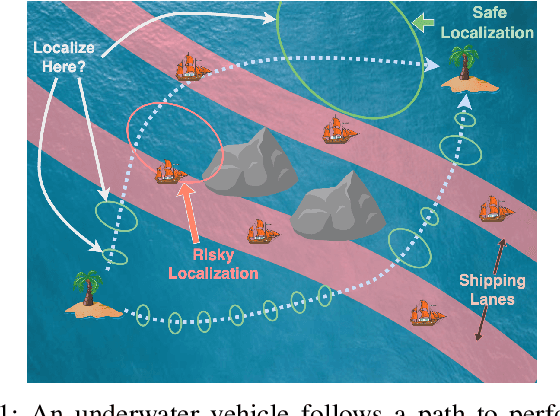
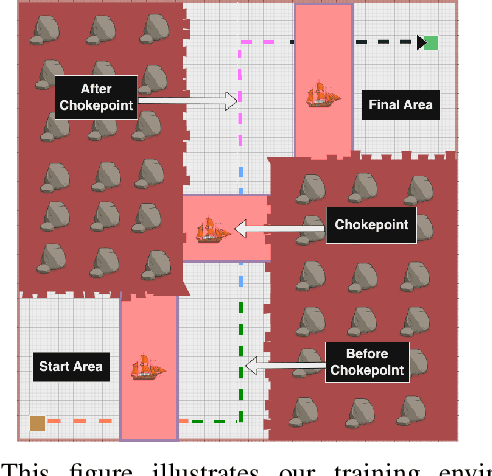
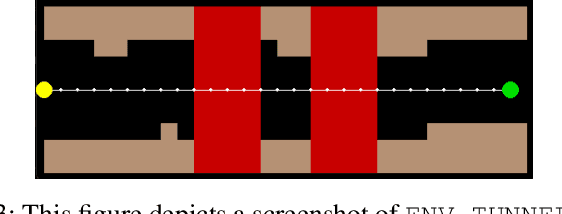
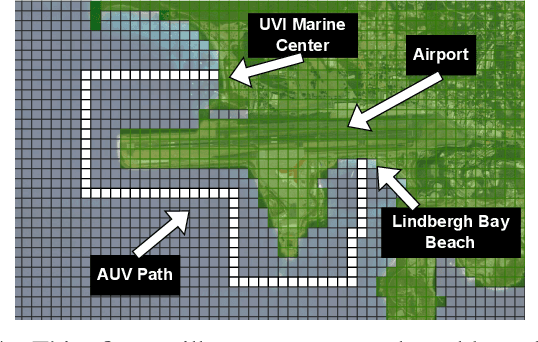
Abstract:Robots often localize to lower navigational errors and facilitate downstream, high-level tasks. However, a robot may want to selectively localize when localization is costly (such as with resource-constrained robots) or inefficient (for example, submersibles that need to surface), especially when navigating in environments with variable numbers of hazards such as obstacles and shipping lanes. In this study, we propose a method that helps a robot determine ``when to localize'' to 1) minimize such actions and 2) not exceed the probability of failure (such as surfacing within high-traffic shipping lanes). We formulate our method as a Constrained Partially Observable Markov Decision Process and use the Cost-Constrained POMCP solver to plan the robot's actions. The solver simulates failure probabilities to decide if a robot moves to its goal or localizes to prevent failure. We performed numerical experiments with multiple baselines.
When to Localize? A Risk-Constrained Reinforcement Learning Approach
Nov 05, 2024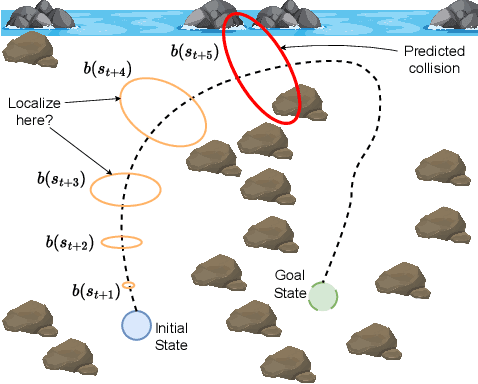
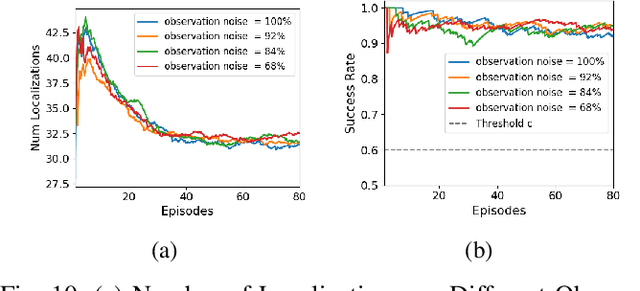
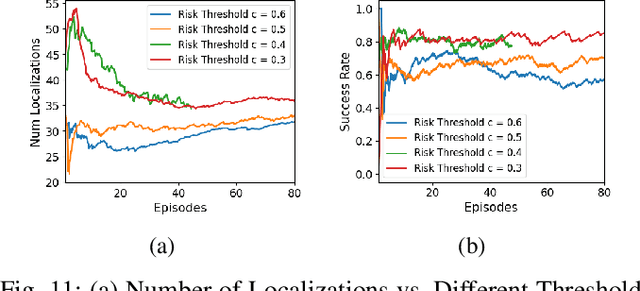
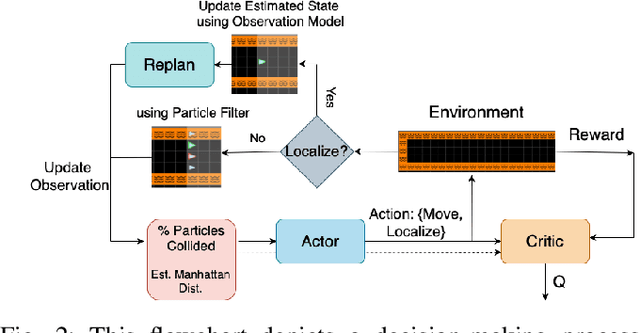
Abstract:In a standard navigation pipeline, a robot localizes at every time step to lower navigational errors. However, in some scenarios, a robot needs to selectively localize when it is expensive to obtain observations. For example, an underwater robot surfacing to localize too often hinders it from searching for critical items underwater, such as black boxes from crashed aircraft. On the other hand, if the robot never localizes, poor state estimates cause failure to find the items due to inadvertently leaving the search area or entering hazardous, restricted areas. Motivated by these scenarios, we investigate approaches to help a robot determine "when to localize?" We formulate this as a bi-criteria optimization problem: minimize the number of localization actions while ensuring the probability of failure (due to collision or not reaching a desired goal) remains bounded. In recent work, we showed how to formulate this active localization problem as a constrained Partially Observable Markov Decision Process (POMDP), which was solved using an online POMDP solver. However, this approach is too slow and requires full knowledge of the robot transition and observation models. In this paper, we present RiskRL, a constrained Reinforcement Learning (RL) framework that overcomes these limitations. RiskRL uses particle filtering and recurrent Soft Actor-Critic network to learn a policy that minimizes the number of localizations while ensuring the probability of failure constraint is met. Our numerical experiments show that RiskRL learns a robust policy that outperforms the baseline by at least 13% while also generalizing to unseen environments.
On the Sample Complexity of a Policy Gradient Algorithm with Occupancy Approximation for General Utility Reinforcement Learning
Oct 05, 2024
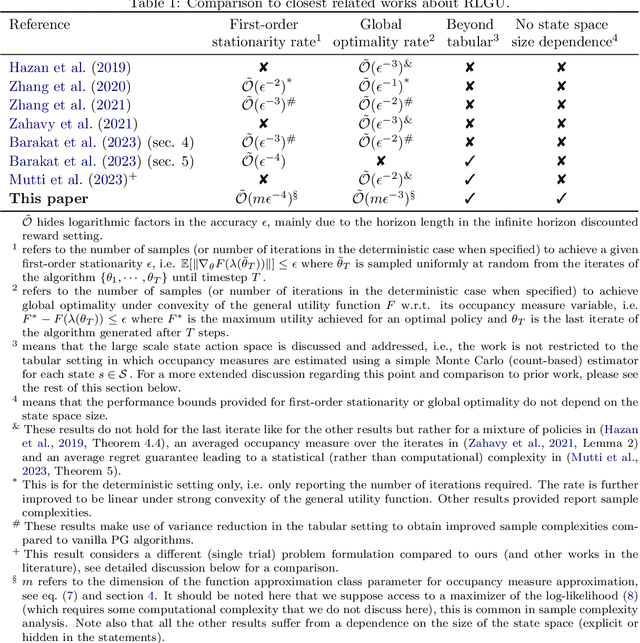
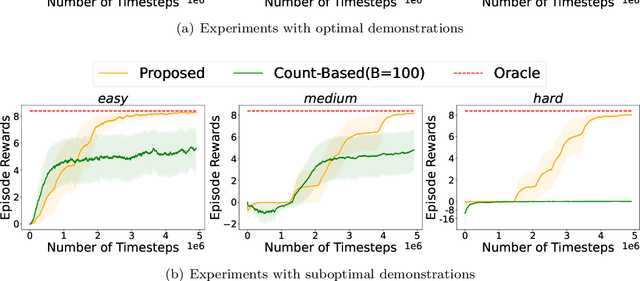
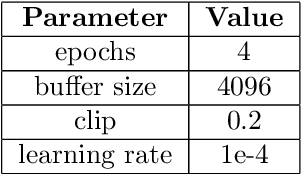
Abstract:Reinforcement learning with general utilities has recently gained attention thanks to its ability to unify several problems, including imitation learning, pure exploration, and safe RL. However, prior work for solving this general problem in a unified way has mainly focused on the tabular setting. This is restrictive when considering larger state-action spaces because of the need to estimate occupancy measures during policy optimization. In this work, we address this issue and propose to approximate occupancy measures within a function approximation class using maximum likelihood estimation (MLE). We propose a simple policy gradient algorithm (PG-OMA) where an actor updates the policy parameters to maximize the general utility objective whereas a critic approximates the occupancy measure using MLE. We provide a sample complexity analysis of PG-OMA showing that our occupancy measure estimation error only scales with the dimension of our function approximation class rather than the size of the state action space. Under suitable assumptions, we establish first order stationarity and global optimality performance bounds for the proposed PG-OMA algorithm for nonconcave and concave general utilities respectively. We complement our methodological and theoretical findings with promising empirical results showing the scalability potential of our approach compared to existing tabular count-based approaches.
 Add to Chrome
Add to Chrome Add to Firefox
Add to Firefox Add to Edge
Add to Edge